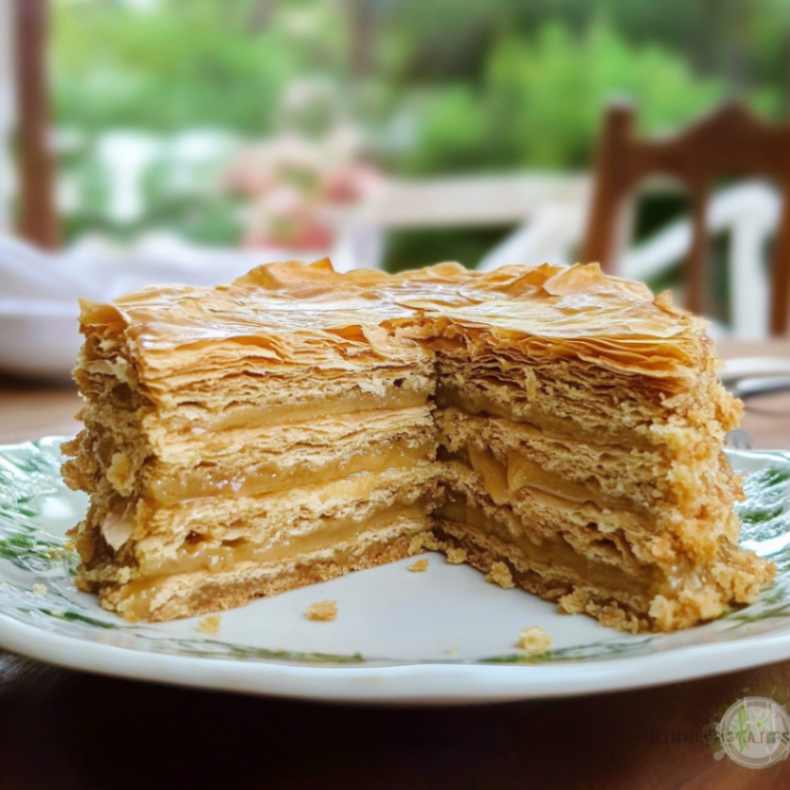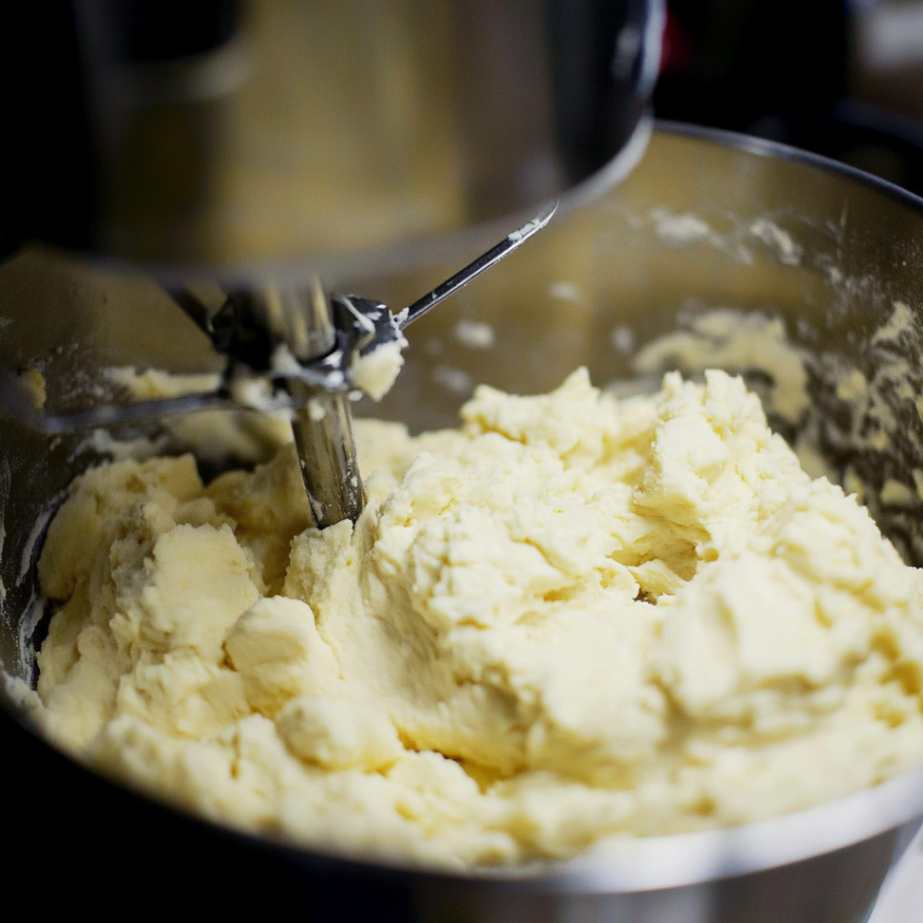In this ultimate guide, we’ll break down everything you need to know about the milhojas cake: from its fascinating history and traditional recipe to modern ingredient swaps, calorie info, and even its surprising connection to billion-dollar cakes. Whether you’re a home baker or just a dessert enthusiast, this article is packed with tips, regional twists, and mouthwatering facts.
Check out Natural Mounjaro Recipe: Your Guide to a Healthier You the perfect balance if you’re looking to enjoy dessert without guilt.
Table of Contents
What is Milhojas Cake?
The meaning behind the name “milhojas”
Let’s start with the name: milhojas cake comes from the Spanish words “mil” (thousand) and “hojas” (leaves or sheets). It refers to the dessert’s signature puff pastry structure dozens of buttery, paper-thin layers stacked together to create a flaky, crunchy masterpiece.
Though it looks complex, the concept is simple: layers of puff pastry interspersed with sweet fillings like whipped cream, pastry cream, or dulce de leche. The result? A dessert that melts in your mouth while giving you a perfect crunch in every bite.
In Latin America, the milhojas cake is often seen as the go-to dessert for birthdays, weddings, and festive gatherings. It’s the kind of treat that turns heads and sparks cravings with just one look.
Traditional origins and early history
The milhojas cake has deep roots in European pastry culture—particularly in France, where a similar dessert called mille-feuille (also “thousand sheets”) originated. But as culinary traditions migrated, the cake evolved into something uniquely Latin American.
In countries like Chile, Colombia, and Argentina, milhojas cake became a household favorite, with locals adapting it using regional ingredients and flavors. Dulce de leche became the preferred filling, often complemented by crushed nuts, powdered sugar, or even a layer of jam.
Even in Spain, you’ll find variations of the milhojas, though they tend to be less decadent than their Latin American counterparts.
Don’t miss our Garlicky Feta Chicken Salad recipe for a savory bite before or after this sweet indulgence.

Milhojas Cake Ingredients & Substitutes
Common ingredients used in milhojas cake
To craft an unforgettable milhojas cake, you’ll need just a few high-quality ingredients. Despite its elegant, multi-layered appearance, this dessert is quite simple at heart. The richness, crispness, and sweetness all come down to what you use and how you layer it.
Here’s a look at the essential ingredients that make up a traditional milhojas cake:
| Ingredient | Function in Milhojas Cake |
|---|---|
| Puff pastry sheets | Creates the flaky, crispy layers that define the cake |
| Dulce de leche | Acts as the creamy, caramel-sweet filling |
| Whipped cream | Adds lightness and balances the sweetness |
| Powdered sugar | Used as a topping for flavor and decoration |
| Unsalted butter | Key to making homemade puff pastry |
| Cornstarch or flour | Helps thicken any cream-based filling |
The signature element of any milhojas cake is the puff pastry. While store-bought frozen sheets work well, especially for beginners, making your own from scratch offers unbeatable flakiness. The key is the layering of butter and dough this technique creates those airy, crispy “leaves” or sheets the cake is named after.
Most milhojas cakes are filled with dulce de leche, a sweetened milk caramel that adds depth and richness. However, regional versions may incorporate custards, jams, or even whipped cream with fruit.
Looking for a crunch? Add chopped almonds or walnuts between layers to complement the softness of the cream.
Creative ingredient substitutions for dietary needs
Yes, you can still enjoy milhojas cake if you have dietary restrictions! Here are some simple substitutions that let you enjoy this classic dessert without sacrificing flavor or texture:
| Dietary Concern | Standard Ingredient | Suggested Substitute |
|---|---|---|
| Gluten sensitivity | Puff pastry | Gluten-free pastry dough |
| Lactose intolerance | Whipped cream, butter | Coconut cream, plant-based butter |
| Low-sugar diet | Dulce de leche | Sugar-free condensed milk caramel |
| Vegan diet | Cream, milk | Cashew cream, coconut whipped cream |
To make a milhojas cake that’s gluten-free, just swap out the pastry for a certified gluten-free version. These are available in many grocery stores and behave similarly in baking. For dairy-free or vegan versions, plant-based creams and butters perform beautifully and pair well with the crispy layers.
Need to lower the sugar content? Use sugar substitutes like stevia or monk fruit in your fillings, or opt for a thinner layer of caramel.
Whether you’re trying to make a lighter dessert or accommodate dietary needs, the beauty of milhojas cake is that it remains adaptable and delicious.
Looking for inspiration? Try this Natural Mounjaro Recipe to balance out your dessert day with something light and nutritious.
Step-by-Step Milhojas Cake Recipe
How to make the pastry layers (puff pastry or homemade dough)
At the heart of every perfect milhojas cake is its impossibly flaky, golden-brown pastry. You can use frozen puff pastry for convenience or make your own laminated dough if you’re feeling adventurous.
Option 1: Using Store-Bought Puff Pastry (Beginner-Friendly)
This method is ideal if you want a fast, foolproof version of milhojas cake without compromising texture.
You’ll need:
- 2 sheets of frozen puff pastry, thawed
- Rolling pin
- Fork for pricking
- Baking sheet & parchment paper
Instructions:
- Preheat your oven to 400°F (200°C).
- Roll out each sheet of puff pastry to about ⅛ inch thick.
- Cut into equal rectangles (about 3×5 inches works well for serving).
- Place on parchment-lined baking sheet, prick with a fork to prevent puffing.
- Cover with another sheet of parchment and weigh down with a second tray.
- Bake for 12–15 minutes until golden and crisp. Let them cool completely.

Option 2: Homemade Dough (Advanced Baker’s Choice)
If you want to take your milhojas cake to the next level, homemade puff pastry is a labor of love. It involves a dough (détrempe) and a butter block (beurrage), rolled and folded multiple times to create dozens of flaky layers.
Here’s a simplified overview:
- Make the détrempe with flour, salt, water, and a little butter.
- Chill, then encase your butter block inside the dough.
- Roll out and fold into thirds—this is called a “turn.” Chill.
- Repeat the turns 4–5 times with resting periods between.
- Roll and cut before baking like the store-bought version.
Homemade puff pastry gives your milhojas cake an unbeatable crispness and rich flavor but it’s time-intensive.
Filling options: from dulce de leche to whipped cream
Now that your pastry layers are ready, it’s time to build the inside of the milhojas cake. The most traditional and beloved filling is dulce de leche, a thick, golden caramel made from sweetened milk. But there are other delicious ways to fill it.
| Filling | Flavor Profile | Tip |
|---|---|---|
| Dulce de leche | Rich, caramel-sweet | Use canned or homemade |
| Whipped cream | Light, airy, slightly sweet | Chill before using |
| Pastry cream | Velvety, custard-style | Best when thickened with cornstarch |
| Chantilly cream | Sweetened whipped cream | Vanilla or almond extract enhances |
| Fruit compote | Tart, fruity | Use berries, guava, or passionfruit |
To assemble your milhojas cake, alternate layers of baked puff pastry with your filling of choice. Start with pastry, spread a generous layer of cream or dulce de leche, and repeat until you reach 4–6 layers. Top it off with a dusting of powdered sugar or a drizzle of caramel.
Let it chill in the fridge for 2–3 hours before serving so the flavors set and the layers fuse slightly this gives a clean slice while preserving the crisp texture.
Tips for Perfecting Your Milhojas Cake
Avoiding soggy layers
One of the biggest challenges in making a flawless milhojas cake is maintaining that crisp, flaky texture—especially after layering it with cream or caramel. If not assembled or stored properly, the pastry can absorb moisture and lose its signature crunch.
Here’s how to keep your milhojas layers perfectly crisp:
- Fully cool your pastry before assembling. Warm pastry will steam and soften your filling layers.
- Bake pastry until golden brown. Underbaked layers will retain moisture and become soggy quickly.
- Add a barrier layer. A light dusting of powdered sugar or a thin brush of melted chocolate on the bottom of each layer can protect it from absorbing too much moisture from your filling.
- Assemble close to serving time. If you need to store the assembled milhojas cake, do it a few hours before serving—not the day before.
Using a firm, thick filling like dulce de leche also helps maintain texture since it’s less likely to seep into the layers compared to whipped cream or fruit.
Layering techniques for best texture and height
The wow factor of a milhojas cake comes from its height and uniformity. That means consistent layering, clean assembly, and strategic stacking.
Here are a few tips to get those bakery-level results:
- Use a piping bag. It helps you apply even filling across the layers, which is crucial for stability and visual appeal.
- Apply gentle pressure on each layer as you stack to bind them together without cracking the pastry.
- Chill between layers. If using a soft filling like whipped cream or chantilly, chill after every few layers to set the structure.
- Trim edges for a clean look. Once assembled and chilled, use a serrated knife to trim the edges. This creates that iconic squared-off look you see in professional milhojas cake presentations.
- Top with flair. Finish with powdered sugar, caramel drizzle, or nuts to add contrast and elevate appearance.
Consistency is key. If you’re making a large cake, weigh your filling portions to ensure each layer gets the same treatment. This avoids lopsided stacks and uneven slicing.
Nutrition and Calories in Milhojas Cake
How many calories are in milhojas cake?
A typical slice of milhojas cake packs around 400 to 550 calories, depending on the filling and number of layers. Made with buttery puff pastry and sweet creams like dulce de leche, it’s rich in both sugar and fat.
| Serving Size | Calories | Sugar (g) | Fat (g) |
|---|---|---|---|
| 1 slice (120g) | 400–550 | 30–45 | 25–35 |
Lighter alternatives for milhojas cake lovers
Want to enjoy milhojas cake with fewer calories? Try these simple swaps:
- Use fewer pastry layers
- Swap whipped cream with Greek yogurt or coconut cream
- Choose sugar-free dulce de leche
- Dust with cinnamon instead of powdered sugar
Milhojas Cake vs. Billionaire Cake
How milhojas cake compares to the billionaire cake
The milhojas cake may not be covered in gold, but it delivers timeless elegance through crisp pastry and sweet fillings. In contrast, billionaire cakes focus on extravagance—think edible gold, diamonds, and jaw-dropping price tags.
| Milhojas Cake | Billionaire Cake |
|---|---|
| Flaky puff pastry layers | Dense luxury cakes with rich fondant |
| Filled with dulce de leche | Decorated with gold and rare gems |
| Rooted in tradition | Built for publicity and spectacle |
The $30 million cake?
Yes, it existed. British designer Debbie Wingham created it for a wealthy client complete with diamonds and no real intention to eat it.
Meanwhile, the milhojas cake stays true to flavor, texture, and family tradition.
FAQs About Milhojas Cake
What is a milhojas cake in French?
In French, a milhojas cake is referred to as mille-feuille, meaning “a thousand leaves.” Both desserts share the same puff pastry layering technique, but Latin American milhojas usually includes richer fillings like dulce de leche and is often taller and more indulgent.
What does milhojas taste like?
The world’s most expensive cake is Debbie Wingham’s $30 million cake, designed for a high-end client. Adorned with diamonds, gold, and rare ingredients, it’s more art piece than dessert. It’s a far cry from the handcrafted, flavor-driven milhojas cake beloved around the world.
What is the most expensive cake in the world?
The world’s most expensive cake is Debbie Wingham’s $30 million cake, designed for a high-end client. Adorned with diamonds, gold, and rare ingredients, it’s more art piece than dessert. It’s a far cry from the handcrafted, flavor-driven milhojas cake beloved around the world.
Conclusion
The milhojas cake is more than just a dessert it’s a cultural classic layered with tradition, flavor, and texture. From its crisp, golden puff pastry to the rich fillings of dulce de leche or cream, every bite tells a story that spans continents and generations. Whether you’re baking it from scratch or savoring a slice at a family gathering, milhojas never fails to impress.
We’ve explored everything from its history and variations to expert baking tips, calorie breakdowns, and how it compares to modern luxury cakes. And if you’re inspired to bring this timeless pastry to your own kitchen, remember: a little patience, the right ingredients, and smart layering are all you need to master the art of the milhojas cake.
for more recipes follow me in facebook page and pinterest.

Milhojas Cake
Ingredients
Method
- Start the Dough: In a large mixing bowl, combine the flour and salt. Add the cold butter (cut into chunks), egg yolks, milk, and liquor. Mix until a medium-consistency dough forms.
- Handle Carefully: Avoid using your hands—use a fork, two knives, or a stand mixer with the paddle attachment instead. Body heat can melt the butter, but keeping small bits of it in the dough is what creates the crisp, flaky texture. Once mixed, wrap the dough tightly in plastic wrap and refrigerate for at least 6 hours, or overnight.
- Preheat the Oven: Set your oven to 350°F (180°C) and allow it to fully preheat.
- Roll and Cut the Layers: Divide the chilled dough into 14 equal pieces. On a floured surface, roll each portion into a thin circle, about 8–9 inches wide. Use a plate as a guide and a paring knife to cut the rounds. Poke each circle all over with a fork to prevent bubbling.
- Bake the Layers: Place each circle on an ungreased baking or cookie sheet and bake for 5–7 minutes, or until golden brown. Let the layers cool completely.
- Assemble the Cake: Spread 3–4 tablespoons of dulce de leche between each baked layer. After every three layers, sprinkle in some ground walnuts, reserving about 1 cup for decoration.
- Finish the Outside: Coat the entire cake with a thin layer of dulce de leche. Garnish the top and sides with a blend of ground walnuts, powdered sugar, and cake crumbs.
- Chill and Serve: Cover the cake and let it rest in the refrigerator. Before serving, bring it to room temperature for the best flavor and texture.
